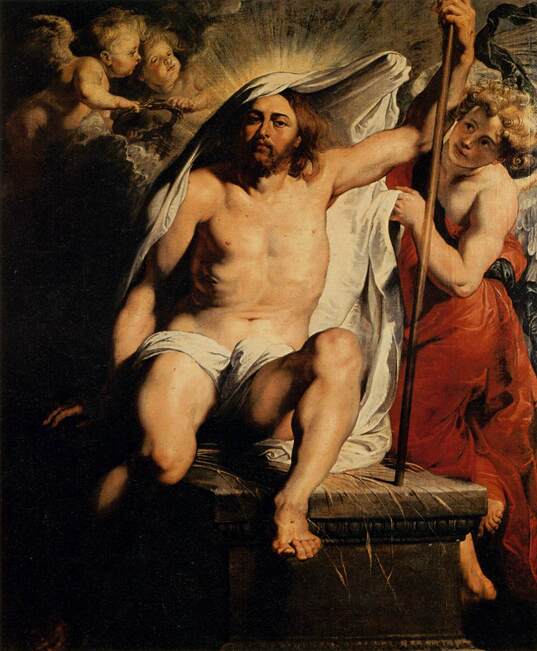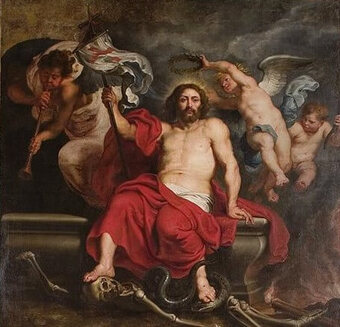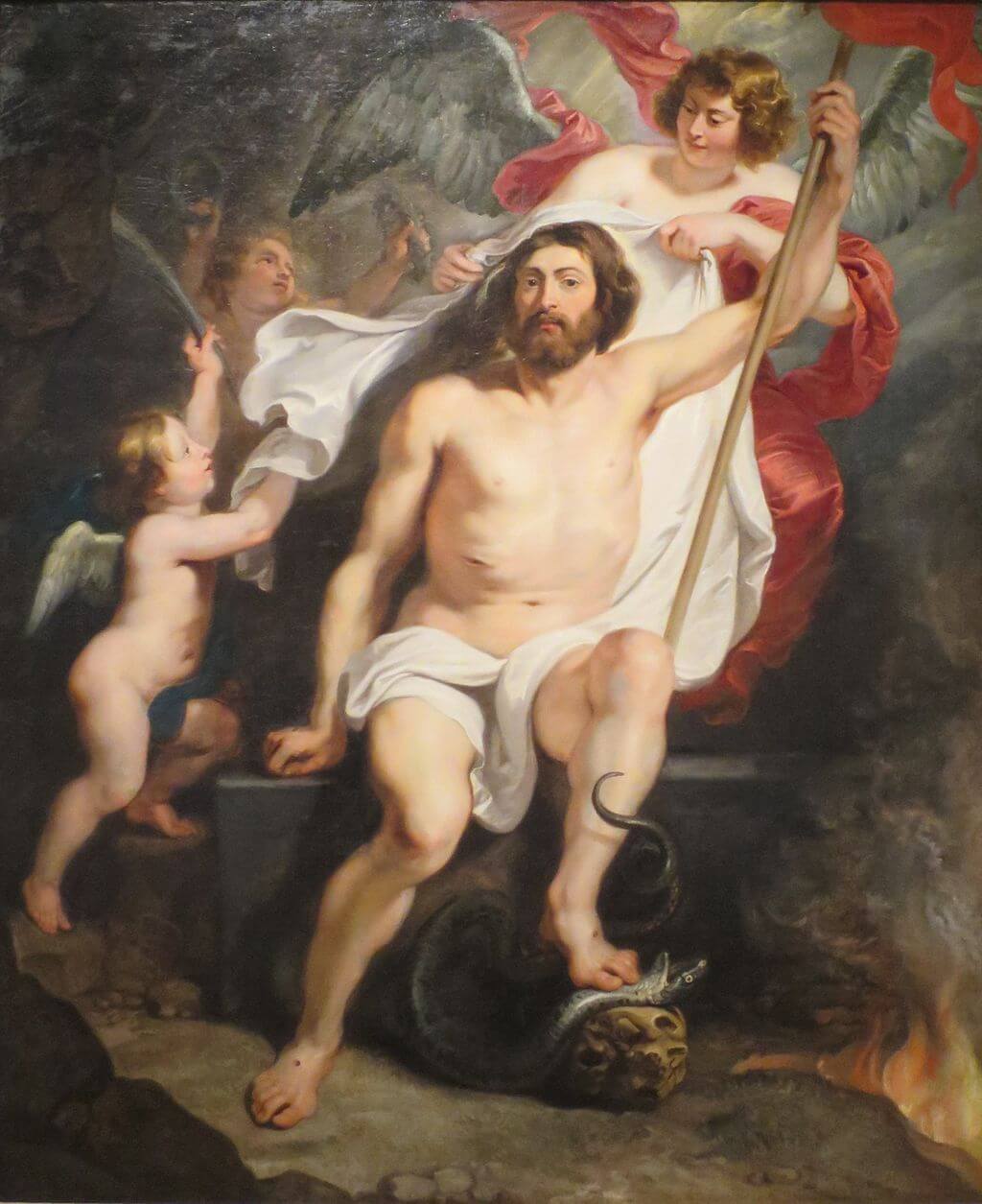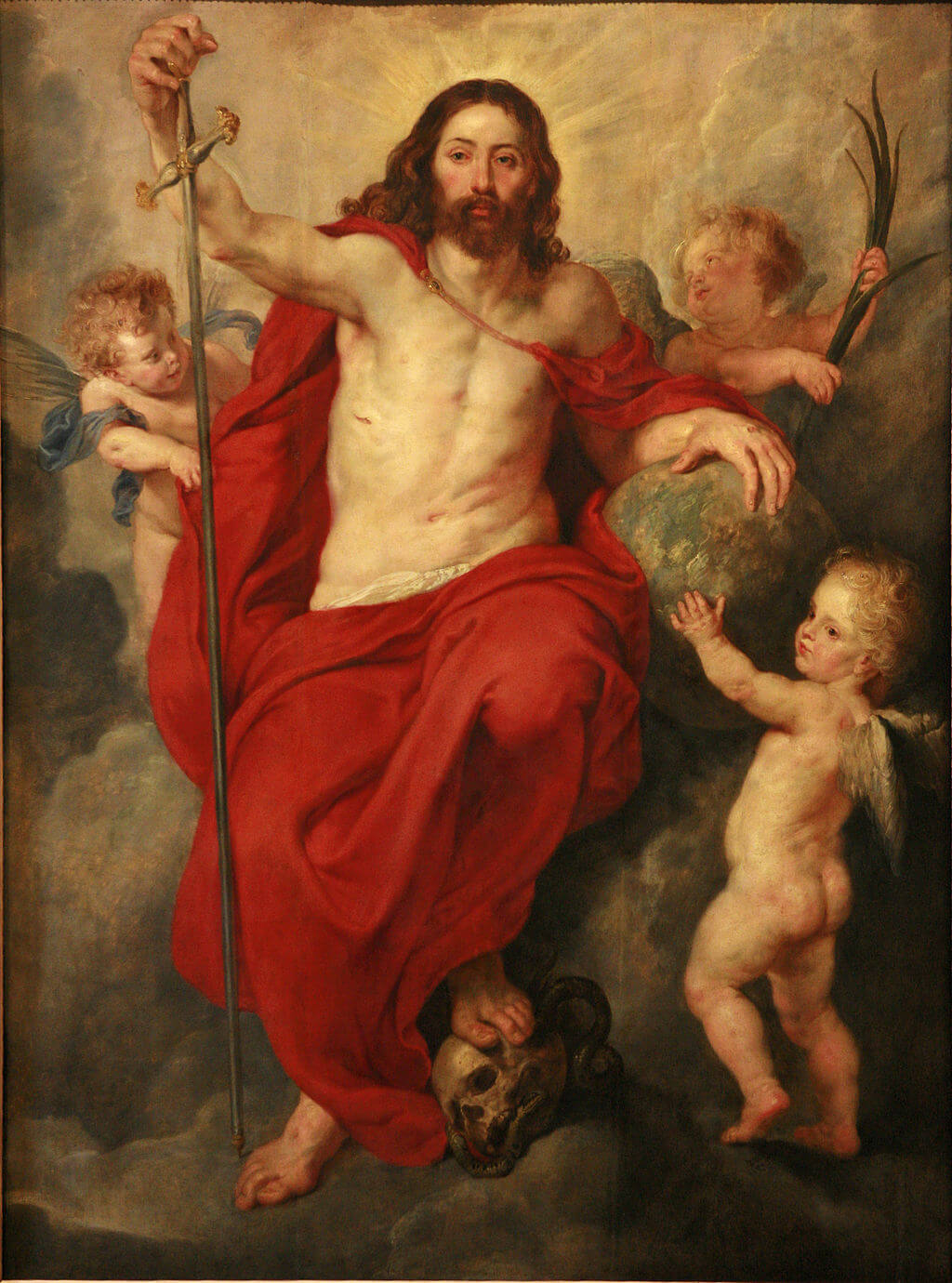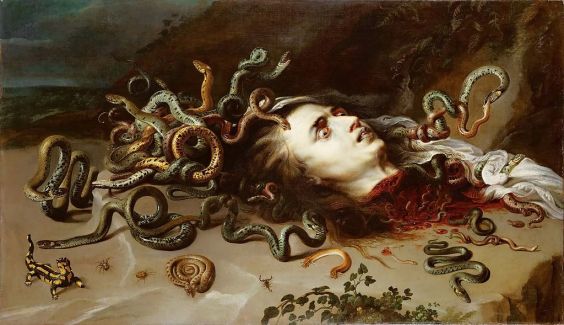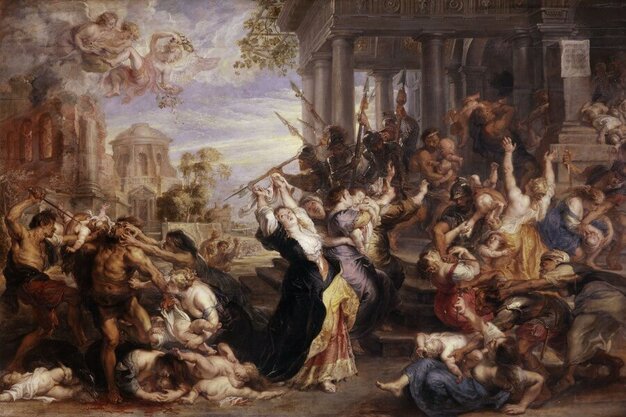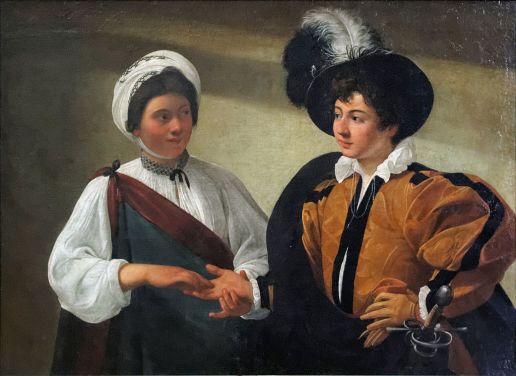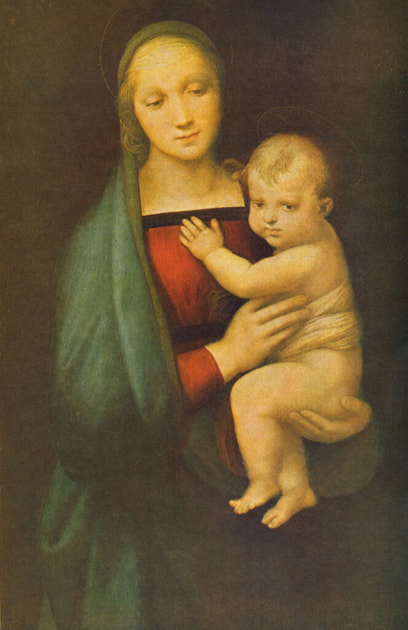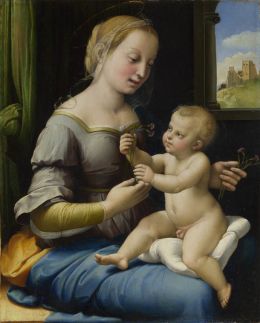|
Where? Palatine Gallery in the Palazzo Pitti
When? 1616 What do you see? Jesus is shown just after he has risen from his grave. On top of his head are bright rays of light shine to indicate his holiness. Light shines brightly on most parts of his body to emphasize that Jesus is alive again. You can still some remains of the wounds that he suffered during the crucifixion (see the middle of his left foot and arm, and the wound, partly in the shadow, on his right side which was pierced by a lance).
On the top left, two small angels are waiting to put the crown of thorns on Jesus (some people say that they took this crown from Jesus, but the head of Jesus is still covered). The large angel on the left, dressed in orange, lifts the cloth in which a dead person is wrapped for burial (also called a shroud). You can imagine that the right hand of this angel is behind the top right of the cloth. On top of the tomb are pieces of wheat that symbolize the bread used in the Holy Communion, which in turn symbolizes the body of Jesus.
Backstory: This painting by Rubens is known under various names, such as ‘The Easter Tomb,’ ‘Christ Resurrected,’ ‘The Resurrection of Christ,’ ‘The Triumph of Christ over Death and Sin,’ and ‘Resurrected Christ Triumphant.’ The reason for some of these alternative names is that Rubens created several other paintings based on this original version. In several of these versions, there is a skull and a snake under the feet of Jesus, which is why some people have also started to refer to the original of Rubens as the triumph over death and sin. One of these later versions is in the Columbus Museum of Art in Columbus, Ohio, another one in the Musée des Beaux-Arts in Strasbourg, France, and other versions are, among others, in Vienna (see above) and in a private collection. Ferdinando de’ Medici, Grand Prince of Tuscany, acquired this painting in 1713, and it entered the collection of the Palazzo Pitti in 1723.
Why the Resurrection? Three days after Jesus is crucified, he rises from the dead. That Jesus died for the sins of humanity and that he rose from his grave are both predicted by the Old Testament and central to Christian faith. The Resurrection is celebrated every year at Easter Sunday. Because of its central importance in Christian faith, it is not surprising that people wanted to have paintings to remind them of such a pivotal moment in the Bible.
The Resurrection was also, more than once, used as the topic for a painting next to a tombstone in a church, to remind the mourners that this person would one day come back to life again (on the day of the Last Judgment). Who is Rubens? Peter Paul Rubens (1577-1640) was one of the most important painters of the Baroque period. Rubens was well-educated and spend eight years in Italy during his twenties, where he got inspiration from great Italian painters, including Caravaggio, Michelangelo, Raphael, Titian, and Veronese. After Rubens came back from Italy, he became the court painter in the Low Countries and based his studio with many assistants in Antwerp, Belgium. He painted many mythological and biblical themes. One great example of a mythological work is his Head of Medusa in the Kunsthistorisches Museum in Vienna. A wonderful example of a biblical work is Samson and Delilah in the National Gallery in London.
Fun fact: Many people have asked themselves whether Jesus has an erection in this painting or whether it is just a ‘random’ fold of the sheet around him. It is not unlikely that Jesus has an erection in this painting as this was something that was not that uncommon in depictions of Jesus in the Northern Renaissance.
Sexuality was considered a normal human trait in the 16th and 17th century and also something that Jesus would have experienced. Showing the erection was a way of communicating that Jesus was really a man that walked around on Earth. While in this painting, the erection is not that explicit, it is a bit clearer in a painting from Maarten van Heemskerck.
0 Comments
Where? Room 26 in the Palatine Gallery in the Palazzo Pitti
When? 1638-1639 Commissioned by? Ferdinando II de’ Medici, the Grand Duke of Tuscany What do you see? In the middle of the painting, you see Mars (the god of war) with his armor, helmet, red cape, shield, and bloody sword. Mars is stepping on top of a book and a drawing. To the left of him, you can see Venus (the goddess of love) who clings to his arm. She tries to seduce him and to pull him back from the war. Venus is largely naked and has a red cloth between her legs. To her left and above her are two small Cupids with wings who try to help her. Below the standing Cupid, you can see some arrows, a caduceus, and an olive branch laying on the ground. To the right of Mars is Alecto, one of the Erinyes whose job it is to punish the moral crimes of humans. Alecto has a torch in one hand and is pulling the left arm of Mars to engage him in the war. To her right are two evil-looking figures that add to the aggressiveness of war in this painting. Below Alecto is the goddess Harmony holding a broken mandolin while being pushed to the ground. To her right is an architect laying on the ground holding a compass and some of his other tools have fallen. Above them are a mother and a child. On the left, you can see a despaired woman dressed in black with her arms up in the air. This woman represents Europe and you can also see her in the middle of Rubens’s earlier painting Massacre of the Innocents in the Alte Pinakothek in Munich. To the left of this woman is an angel holding a globe with a small cross on top of it. Above this angel is the Temple of Janus which is on the Roman Forum in Rome.
Backstory: Rubens received a commission for a painting for the Grand Duke of Tuscany through an intermediary in Florence called Justus Sustermans. Rubens was allowed to pick his own topic, and following his desire for peace, he proposed to create a painting on the consequences of war. He created a couple of sketches on his ideas for the painting which the Duke approved.
Rubens painted the work while he was in his studio in Antwerp. This painting is sometimes also referred to as the Horror(s) of War. The painting reflects Rubens’ views on how the Thirty Years’ War between 1618 and 1648 affected Europe. Symbolism: Venus, the goddess of love, tries to persuade Mars, the god of war, to end the violent war, but Mars is not listening. So, this painting symbolizes the victory of warfare over peace. The gloomy woman dressed in black, who is not wearing any jewelry, represents Europe, which has suffered from war, abuse, and looting during the Thirty Years’ War. The door of the Temple of Janus is open, which was only the case during wartime as the door was closed when there was peace. The globe with the cross on top of it represents the Christian world. The arrows, caduceus, and olive branch represent the absence of peace. In addition, there are also several symbols present to indicate the consequences of war. Specifically, war has bad consequences for life (indicated by the woman holding the baby), culture (indicated by Mars stepping on a book and a drawing), arts (indicated by Harmony being pushed to the ground while holding the broken mandolin), and crafts and architecture (indicated by the man on the right holding a compass. What is the Thirty Years’ War? This very complex war took place between 1618 and 1648 and involved the area which is currently Germany. Many different countries were involved at different stages of the war, including Austria, Denmark, England, France, Spain, and Sweden. There were a total of eight million casualties in this war. This war started as one between Catholic and Protestant areas in Europe but developed later into a war between some of the most powerful European countries. Who is Rubens? Peter Paul Rubens (1577-1640) was born near Cologne in Germany where his family was exiled. When Rubens was ten years old, his family returned to Antwerp where they were originally from. Antwerp was one of the bigger cities in Europe at that time. Rubens received a good education and traveled throughout Europe to learn about art. He spent several years in Italy and was impressed by the art that he saw in Florence, Rome, and Venice. He got inspired by artists such as Caravaggio, Michelangelo, Raphael, and Titian. For example, the Venus in this painting shows quite some similarities to the Venus as painted by Titian in the Venus of Urbino which is in the Uffizi Museum. At age 29, Rubens returned to Antwerp where he built a large Italian-style house which served as his house and his art studio. The house has survived and is now called the Rubenshuis and serves as a museum about Rubens.
Fun fact: Throughout his life, Rubens traveled all across Europe to complete different commissions. He was the court painter for several kings and queens. Rubens did not like war and was passionate about creating peace. So, during his trips through Europe and while visiting the leaders of several countries, he started to act as a peace negotiator between the different countries involved in war.
As an example, Rubens was very active as a diplomate between 1627 and 1630 trying to bring peace between England and Spain. However, he always combined his diplomatic trips with studying art in the different countries as he was first and foremost an artist.
Where? Room 21 in the Palatine Gallery in the Palazzo Pitti
When? 1608 Commissioned by? Fra Francesco dell'Antella, the Florentine secretary to Alof de Wignacourt, who was the Grand Master of Malta What do you see? A somewhat chubby child is sleeping. The child represents Cupid, the god of desire, erotic love, affection, and attraction. Cupid is resting with his head on top of his quiver with arrows and is holding an arrow (with a small piece of red) in his left hand. You can also recognize the bow with a broken string in front of his legs. The wings of Cupid are also present. While the left wing is clearly visible, the black background hides a large part of the right wing of Cupid. Backstory: Caravaggio created this painting while he was on Malta, where he became an honorary knight. It is the only painting he created there that is known with certainty, evidenced by an inscription on the back of the painting (though he probably created several others in Malta as well). The sleeping Cupid became a popular topic in Renaissance art after Michelangelo’s sculpture of a sleeping Cupid in 1496 (this sculpture is lost, probably it got destroyed in a fire in London in 1698). Michelangelo’s sculpture, in turn, was inspired by old Greek statues of the sleeping Cupid. Symbolism: The depiction of Cupid, with his broken bowstring and his arrows aside, represents the abandonment of earthly pleasures. Whereas an active Cupid is typically seen as a symbol for spreading the love, this particular representation has a completely different meaning. The painting was commissioned by a friar to remind him and others of their vow of chastity. Who is Cupid? Cupid (Eros in Greek) is the god of desire, erotic love, affection, and attraction. He is the son of Venus and Mars. He is often portrayed as a chubby boy. His main attributes are his bow and arrow, and he typically has two kinds of arrows. The first kind are arrows with a sharp golden tip, which can fill someone with uncontrollable desire. The second kind are arrows with a blunt tip of lead, which can fill someone with aversion and the desire to flee. Why Cupid? As Cupid can both fill someone with uncontrollable desire and fill someone with aversion, he makes a great subject for allegories. Love and hate have always been great topics for art as they represent some of the strongest emotions that people possess. The particular way in which he is represented in an artwork can tell a wide variety of different stories. The subject of a sleeping Cupid was already frequently used by the ancient Greek, who mainly used this subject as a symbol of love as an everlasting emotion, which is present whether someone is awake or asleep. Caravaggio has also included Cupid in some of this other works, such as his painting The Musicians in the Metropolitan Museum of Art.
Who is Caravaggio? Michelangelo Merisi da Caravaggio (1571-1610) is a student of Simone Peterzano, who in turn was a student of Titian. Caravaggio had an important influence on the formation of the Baroque period. So much so, that the followers of his style are referred to as Caravaggisti. While Caravaggio never had a school to share his techniques with others, his work has had a big influence on artists like Rubens, Bernini, and (indirectly) Rembrandt. Caravaggio created many masterpieces including his Medusa in the Uffizi Museum and The Fortune Teller in the Louvre.
Fun fact: Quite some people have commented on this painting, stating that the child looks dead. An analysis by a doctor, published in the famous medical academic journal The Lancet, states that the sleeping Cupid suffers from juvenile rheumatoid arthritis. Symptoms include the yellowish skin of the child (indicating jaundice), the blue/purple color in the lips and ears indicates a low level of oxygen saturation, his body seems to suffer from edema, and his joints are inflamed. The question remains why Caravaggio would paint a sick or dead child. It could be an effective way to deliver the message of the painting, or it could be a macabre joke of Caravaggio (which is certainly not impossible given the turbulent life that he lived).
Interested in a copy for yourself? Poster or canvas
This Madonna by Raphael may look like a simple painting, but it is highly admired because of how harmonious and peaceful it is and the motherly love it depicts. It reminds many of how their own mother must have held them as a baby or how they held their own babies (which is something that is hard to describe in words).
Backstory: This painting is often referred to as the Madonna del Granduca (or Gran’ Duca). This name has been given as the painting was owned by the Grand Duke of Tuscany, Ferdinand III. He bought the painting in 1799 for around $600. He loved this painting so much that he took it with him everywhere he went. Because of this, the painting is sometimes referred to as the Madonna del Viaggio (which is Italian for ‘journey’). Raphael painted this work while he was in Florence. During that time he got influenced by the techniques of Leonardo da Vinci who was also in Florence during that time. We can specifically identify the use of the sfumato technique (which is a soft transition between different colors and tones). This technique was one of the specialties of Da Vinci. In this painting, Raphael uses bright colors for the clothes of Mary but makes sure that the transition between the different colors is quite smooth. You can also see this technique applied in the face of Mary, for example, around her eyes. Symbolism: This painting shows the motherly love of the Virgin Mary for Baby Jesus. The blue color of Mary’s mantle symbolizes her role as the Queen of Heaven. The red color of her gown symbolizes the blood of Christ, referring to the crucifixion of Jesus. Madonnas by Raphael: During his career, Raphael painted many Madonnas. Most of these paintings have become very popular because of the way Raphael painted Mary with dignity, grace, and purity, something that he could do like no other artist. The current painting is one of the first Madonnas that he painted. Other highly appreciated Madonnas by Raphael are the Alba Madonna in the National Gallery of Art, the Madonna of the Goldfinch in the Uffizi Museum, and the Madonna of the Pinks in the National Gallery in London.
Who is Raphael? Raffaello Sanzio da Urbino (1483-1520) was born in Urbino (almost 100 miles East of Florence), which explains his last name. He is popularly known as Raphael. When he was 15 years old, he moved to Perugia (about 80 miles Southeast of Florence) where many artists lived, and he probably became an apprentice of Pietro Perugino. He learned very quickly and completed his training by 1500. He gained a reputation as a very talented painter and got his first commissions before he was 20 years old.
Around 1504, Raphael moved to Florence where he was influenced by the works of Leonardo da Vinci who was in Florence between 1500 and 1506. While Raphael learned a lot from other painters, he always kept developing his own unique style. In 1508, Pope Julius II asked him to come to Rome where he spent the rest of his life. Fun fact: The dark background in this painting helps to emphasize the beautiful blue and red colors of Mary’s clothes. While this contrast is admired and one of the strengths of this painting, recent research using x-rays has shown that Raphael originally included a background of architectural structures and a landscape. These backgrounds are typical for the Madonnas that Raphael painted as can be seen in the examples of his other Madonnas above. The dark background that we see in the current version of the painting has been added later on by another painter. This may have occurred around the time of Caravaggio, who successfully incorporated dark background into his paintings. Interested in a copy for yourself? Poster or canvas |
Categories
All
|
- Home
- Blog
-
Museums
- Alte Pinakothek
- Art Institute of Chicago
- Baltimore Museum of Art
- Barber Institute of Fine Arts
- Bargello
- Barnes Foundation
- British Museum
- Church of Sant’Anastasia
- Cleveland Museum of Art
- Courtauld Institute of Art
- Detroit Institute of Arts
- Frans Hals Museum
- Galleria Borghese
- Gallerie dell'Accademia
- Getty Museum
- Guggenheim
- Hermitage Museum
- Kunsthistorisches Museum
- Kunstmuseum Basel
- Legion of Honor Museum
- Louvre
- Mauritshuis
- Metropolitan Museum of Art
- Musee d’Orsay
- Museum of Fine Arts in Boston
- Museum of Modern Art
- National Gallery in London
- National Gallery of Art
- National Museum in Poznań
- Norton Simon Museum
- Ny Carlsberg Glyptotek
- Palace of Versailles
- Palazzo Pitti
- Palazzo Vecchio
- Petit Palais
- Philadelphia Museum of Art
- Prado
- Pushkin Museum
- Ravenna Art Museum
- Rijksmuseum
- San Diego Museum of Art
- Santa Maria delle Grazie
- St. Peter's Basilica
- Städel Museum
- Statens Museum for Kunst
- Tate Britain
- Tate Modern
- Timken Museum of Art
- Uffizi
- Vatican Museums
- Wallace Collection
-
Artists
- Altdorfer
- Anguissola
- Berlin Painter
- Bosch
- Botticelli
- Boucher
- Bronzino
- Bruegel the Elder
- Brunelleschi
- Cabanel
- Caillebotte
- Canova
- Caravaggio
- Carpeaux
- Cezanne
- Cimabue
- David
- Degas
- Delacroix
- De Maria
- Donatello
- El Greco
- Fontana
- Fra Angelico
- Fragonard
- Gauguin
- Gentileschi
- Gericault
- Gonzalez-Torres
- Goya
- Hals
- Hogarth
- Hokusai
- Ingres
- Leonardo da Vinci
- Lippi, Filippo
- Longhi, Barbara
- Lorrain
- Makovsky
- Manet
- Massys
- Matisse
- Merian
- Michelangelo
- Mochi
- Modigliani
- Monet
- Panini
- Parmigianino
- Perugino
- Picasso
- Pisanello
- Raphael
- Rembrandt
- Renoir
- Reynolds
- Rivera
- Rodin
- Rubens
- Scultori
- Seurat
- Steen
- Tintoretto
- Titian
- Toulouse-Lautrec
- Turner
- Uccello
- Van der Weyden
- Van Dyck
- Van Eyck
- Van Gogh
- Van Hemessen
- Vasari
- Velazquez
- Vermeer
- Veronese
- Vigée Le Brun
-
Locations
- Books
- About Us

